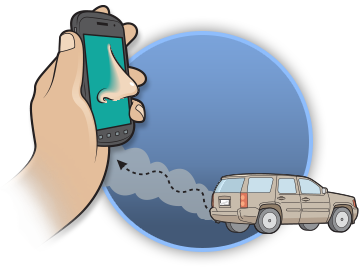
手机有了嗅觉
<a href="../201812/t20181229_903800.html">2017年的日全食激发了大众的科学热情</a>(科学60S)
0:00/0:00
最新发布时间:
2015-03-14
Canary out, Smartphone in for Gas Detection
手机有了嗅觉
撰文/播音 辛西娅 • 格雷伯(Cynthia Graber)
翻译 南の生
审校 李轩
Devices that detect potentially hazardous gases or airborne environmental pollutants are out there. But they’re expensive and bulky. Now M.I.T. researchers say they’ve developed a way to get the same detection abilities—with your smartphone.
能检测潜在有害气体或空气污染物的设备虽然有,但它们昂贵又笨重。最近, MIT(麻省理工学院)的研究人员称,他们开发出了一种与这类设备拥有相同检测能力的方法,但使用的仅仅是一部智能手机。
The research team modified what are called near-field communication tags, or NFC tags. Smartphones with NFC capabilities send out magnetic field pulses. The magnetic field creates an electric current on the tag that the phones pick up. Such systems are typically used to track products or drugs.
研究小组改良了被称为近场通讯标签(near-field communication tags, NFC tags)的装置。有NFC功能的智能手机可以发出磁场脉冲,磁场在标签上产生电流让手机读取。这种系统通常用来追踪商品或药物。
For the new application, the scientists added links to the circuit made of carbon nanotubes. Each link responds to one particular gas, by changing how the nanotubes conducts electricity. By sensing the change in electric current on the tag, the smartphone signals that it has detected the gas in question.
在新的应用程序里,科学家为碳纳米管电路添加了连接,通过改变纳米管产生电流的方式,使每个连接响应一种特定气体。通过检测标签上的电流变化,智能手机可以发出检测到对应气体的信号。
The method was tested with ammonia, cyclohexanone and hydrogen peroxide. And the tags could sense the substances at levels of a few parts per million. The research is in the Proceedings of the National Academy of Sciences. [Joseph M. Azzarelli et al, Wireless gas detection with a smartphone via rf communication]
用这种方法可以检测到氨、环己酮、过氧化氢,并且标签的感应灵敏度可以到几百万分之几。该研究发表在《美国国家科学院院刊》(Proceedings of the National Academy of Sciences)上。
Such inexpensive tiny tags require no external power. The scientists say their NFC tag system has the potential to be widely used to monitor gases that can affect health, safety and the environment.
这种便宜的小标签不需要额外供电。科学家称NFC标签系统在监测影响健康、安全、环境的气体方面,有极广泛的应用前景。
查看更多
©2011- 版权所有:中国数字科技馆
未经书面许可任何人不得复制或镜像
京ICP备11000850号-1 京公网安备11010502039775号
京公网安备11010502039775号
信息网络传播视听节目许可证0111611号
国家科技基础条件平台
未经书面许可任何人不得复制或镜像
京ICP备11000850号-1
 京公网安备11010502039775号
京公网安备11010502039775号 信息网络传播视听节目许可证0111611号
国家科技基础条件平台

















